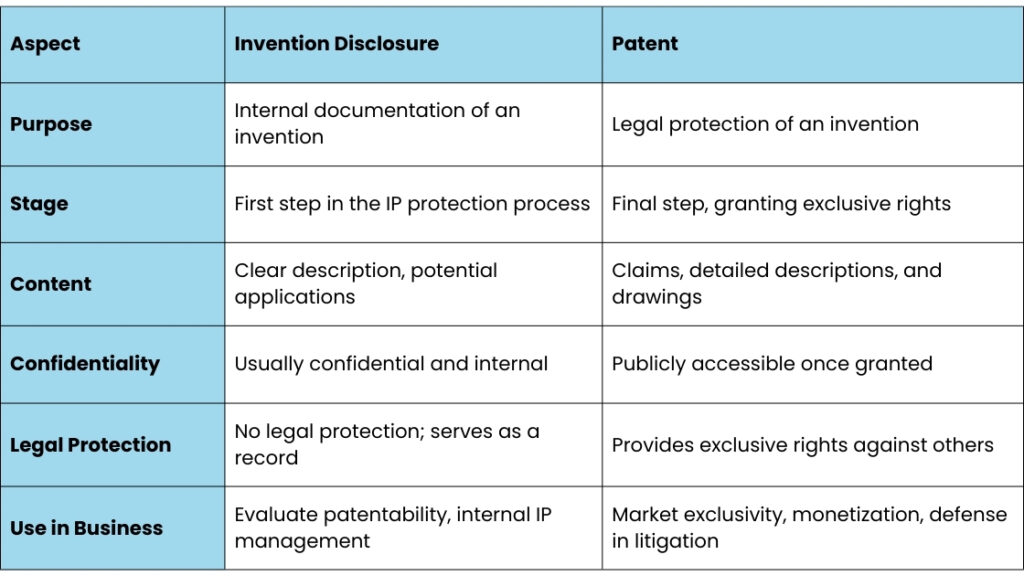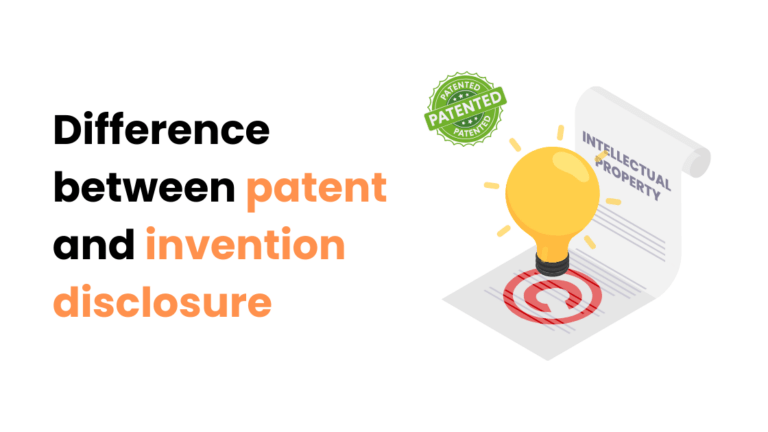So, let’s say you’ve just had that idea, the one that’s going to change everything.
Maybe it’s a gadget, a software tweak, or an innovative process no one’s seen before.
Exciting, right?
But before you start telling everyone, there’s a crucial step you don’t want to miss: securing that idea so it truly becomes yours.
But what’s the right way to do it? Should you file an invention disclosure? Get a patent? Or maybe both?
Let’s break the classic invention disclosures vs patents debate, and how they work together to protect the very core of your innovation.
Invention Disclosure: Your Idea’s First Line of Defense
Consider a tech startup that develops a unique AI algorithm for predictive analytics.
They submit an invention disclosure to document and evaluate the innovation internally.
Once evaluated, if the invention holds strong commercial potential, they file for a patent to prevent competitors from using their algorithm.
This two-step approach helps secure IP rights and position the startup for potential investment or partnerships.
Think of an invention disclosure as creating the first official record of your idea.
This document, usually handled internally within your company, is where you capture the essential details of your invention.
From the problem it solves to how it works, this disclosure form isn’t just paperwork—it’s an official “I thought of it first” moment.
Here’s why it matters
Let’s say an engineer at an AI startup developed a method to improve natural language processing models.
Instead of diving into a patent application right away, he completed an invention disclosure form.
Later, the company discovered that a competitor had released a similar product, but his invention disclosure’s timestamp gave him priority—leading to a successful patent application.
That’s how invention disclosures provide an edge.
- Establishes a Date of Creation: The invention disclosure form is essential to prove when your idea was born, which can be valuable if there’s ever a dispute over who came up with it first.
- Evaluates Patent Potential: With an invention disclosure, you can check your idea’s “patentability.” Is it truly new? Has anyone done it before? Does it stand out from the rest? If the answer is yes, this might be your green light to pursue a patent.
- Keeps Your IP Organized: For companies with a stream of new ideas, invention disclosures are like a central library of IP. They help track the evolution of ideas, even if some might not make it to market.
- Capture Valuable Ideas Early: The sooner an idea is documented, the easier it is to protect it later.
- Align with Business Strategy: Companies can evaluate invention disclosures to decide if they align with larger business or R&D goals.
- Establish Inventor Rights: Documentation serves as an inventor’s initial claim on their work, useful in cases of co-creation or joint ownership with other institutions.
Download free sample invention disclosure form :
Patent: The Legal Powerhouse
Unlike an invention disclosure, a patent is a legal protection mechanism granted by the government.
When a patent is issued, it allows the inventor exclusive rights to prevent others from making, using, or selling the invention. Here’s what sets it apart:
- Legal Protection: A patent legally blocks others from exploiting your invention, providing 20 years of exclusivity.
- Supports Market Advantage: Patents are often instrumental for companies looking to build a competitive edge or license their innovations.
- Higher Investment Potential: Securing a patent can make an invention more attractive to investors or partners, especially in IP-driven industries like pharmaceuticals, technology, or manufacturing.
Did you know, 2023 saw a record high in global patent applications, with significant growth in AI and green technologies? [WIPO report]
This surge highlights a global trend: companies recognize that patents aren’t just IP protection; they’re strategic business tools.
- Market Exclusivity: With a patent, you can block competitors from entering the market with the same product, giving you a significant advantage.
- Monetization: Patents can be licensed out, generating revenue without you having to make the product yourself.
- Attracting Investment: A strong patent portfolio can attract investors by showing that your company has valuable, protectable technology.
- Defensive Strategy: Patents can be used defensively in legal disputes, helping to protect your company from infringement claims.
- Building a Brand: Patents contribute to a company’s image as an innovator and can be a key part of its brand identity.
The Key Differences Between Invention Disclosure and Patent
So, how do these two stack up? Here’s a quick comparison of invention disclosure vs. patent.

Why Both Matter for IP Success
Understanding invention disclosures and patents is key to managing and protecting intellectual property.
Companies that utilize both not only secure legal rights over their innovations but also strengthen their innovation pipeline and IP strategy.
Take Tesla, for example.
They strategically patent core technologies while keeping internal innovation records.
This dual approach opens up potential licensing deals that align with Tesla’s market strategy, turning patents into income sources.
#1 Take Action: Why You Should Start with an Invention Disclosure
An invention disclosure is a foundational record that helps companies harness inventors’ ideas, align them with IP goals, and position them for possible patenting.
InspireIP’s IP Assist streamlines this entire process, from capturing initial ideas to managing disclosures and facilitating patent filing, creating a centralized space to secure and evaluate innovations before they reach the patenting stage.
#2 Timing Is Everything: Why Early Disclosure Matters
Filing a disclosure early in the development process prevents potential IP issues.
A delayed disclosure could lead to public exposure, jeopardizing patent eligibility.
Being proactive with invention disclosures ensures an invention remains eligible for patent protection in the U.S. and globally.
#3 Ensuring Seamless Transition from Disclosure to Patent
The invention disclosure process should be a structured “brain dump” of the invention.
Invention disclosure software makes it easy to transition from disclosure to patent, often accelerating the patent drafting process by several weeks by preserving the invention’s details, ensuring broad coverage of its unique aspects, and providing a streamlined experience from ideation to legal protection.
Best Practices for Invention Disclosures
To optimize invention disclosures and their potential for IP protection, consider these best practices:
- Be Thorough: Detail every aspect, from technical specifications to unique design elements.
- Use a Template: Following a structured format ensures consistency across disclosures.
- Collaborate with Experts: Patent professionals can help identify any gaps or potential issues early on, streamlining the patenting process later.
Related Read: Invention Disclosure: What it is and what does it mean for a company?
Wrapping Up
Invention disclosures and patents might sound like legal jargon, but they’re powerful allies in securing your ideas.
So, if you’re ready to take that big idea to the next level, protect it from day one by documenting, assessing, and patenting—because in today’s world, it’s all about protecting what’s yours.
Both invention disclosures and patents are essential, each serving a unique purpose in protecting intellectual property.
InspireIP’s solutions help innovators document and patent their ideas efficiently, creating a seamless, end-to-end IP protection strategy.
Would like a demo of our invention disclosure software?



